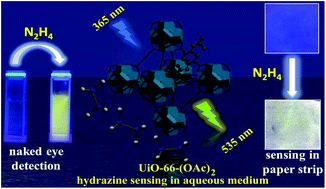Rapid switch-on fluorescent detection of nanomolar-level hydrazine in water by a diacetoxy-functionalized MOF: application in paper strips and environmental samples†
Abstract
Here, we present a new diacetoxy-functionalized UiO-66 metal–organic framework (MOF) for the trace level detection of hydrazine in water. The MOF material (1) was solvothermally prepared by the reaction between ZrOCl2·8H2O and 2,5-diacetoxy-1,4-benzenedicarboxylic acid (H2BDC–(OCOCH3)2). The desolvated material (1′) showed a highly selective fluorescent turn-on signal towards hydrazine in water, which can be visualized by the naked eye under a UV lamp. Within 1 min of hydrazine addition, there was 14-fold fluorescence enhancement. The probe can detect hydrazine up to the nanomolar level (detection limit = 78.8 nM) in water. This detection limit is the lowest among MOF-based fluorescent probes for hydrazine. The material was also utilized for the sensing of hydrazine in paper strips and environmental water samples. Hydrazine-selective deprotection of ester groups anchored with the ligand is the principal reason behind the switch-on nature of sensing.



 Please wait while we load your content...
Please wait while we load your content...